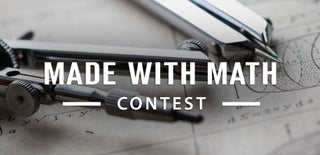Introduction: Harmonic Analyzer : Mechanical Lasercut Signal Plotter
Hello everyone !
I'm a lasercut fan since three years for now, and always been a bit curious about mechanical computers. Those mechanism This instructables will help you to make your own signal synthetizer designed to be cut in wood. You can download all the files on its Thingiverse page.
This machine composes mechanically a Fourier series, which is a sum of
(theorically) infinite sine waves, but here, we are going to sum up 5 sines.
This Instructables is separated in 3 parts :
I. Fourier analysis principle / History
II. The main parts & tower assembly
III. User guide : How to use the machine
You will also need to gather some material :
Supplies
Required material :
All lasercut parts are made into 3mm sheets. I personnaly used MDF for its value for money. About quantity, i had to use 7 sheets of 60x30cm, to give you an idea.
Hardware :
Step 1: Some History About the Machine
Before electronics, calculations could be provided by mechanic solutions. At the end of 19th century, many of this mechanical computer were manufactured got some reputation for helping the physicist Albert Michelson during his spectroscopy research.
Thanks to engineerguy, who published a demonstration of the working machine, i decided to build my own. This device can synthetize signals from 20 sines simultaneously (using oscillating motions of multiple frequencies, from sin(x) to sin(20x) ), but larger versions were made counting up to 80 waves ! And as my first version, the lasercut model you're about to make counts 5 sines.
You can check his videos here :
A 100-year-old mechanical computer - Introduction
A 100-year-old mechanical computer - Synthesis
Step 2: What Is Harmonic Analysis ?
Disclaimer : For real pertinent explanations or further informations about harmonic analysis and Fourier series, I suggest viewers to refer to specialized sources.
Harmonic analysis is the study of periodic signals as addition of basic waves, through the Fourier series and Fourier transforms.
Such a domain is too rich to be fully explained, so i will use my own words : A periodic signal or function (which means a signal that repeats itself permanently) can be observed as the superposition of basic waves with multiple frequency and variable amplitude. Those basic waves are sine waves.
When we decompose a signal to basic waves, this is analysis.
We can also build signals from primitive waves. that is synthesis.
Harmonic analysis is used in mathematics or radiocommunications to simplify the study of the received signals, as it is composed of many sub-signals with different frequencies.
Step 3: What's in That Tower ? (Main Parts)
To draw a signal, we need several mechanical principles that will succeed through the main components of the machine :
- Yellow : The main crank,
- Red : The cone gear set,
- Green : The independent gear set,
- Blue : The rocker arms,
- Orange : The magnifying levers,
- Cyan : The spring adder,
- Purple : The pen holder,
- Pink : The sliding frame.
You will have the assembly instructions about all those parts all along this Instructable, and their role in the process.
Step 4: 1st Floor Frame
The first floor holds the two gear set and the sliding frame.
Assembly : Put enough glue to make it strong. Don't hesitate to wait enough time to let glue dry sufficiently.
Step 5: The Cone Gear Set (1st Floor)
On this set, all the gears are attached together.
The rotation of this cone represents the evolution of time. The assembly is not difficult (not yet).
Assembly : Put all the cogwheels in the same direction : a dot shows you the direction where all the wheels must be glued.
Don't forget to firmly glue the set, especially the teeth between each cogwheel : put a tiny drop of glue on each tooth.
Step 6: The Independent Gears Set (1st Floor)
On this set, all the gears are independants.
Every gear has an X/5 ratio with the Xth gear from the cone set. So, the first gear will move at a 1/5 speed, the second one at 2/5 speed, etc... until 5/5 speed.
The ratios are :
- 15 teeth / 75 teeth - Total : 90 (ratio 1:5)
- 26 teeth / 65 teeth - Total : 91 (ratio 2:5)
- 33 teeth / 55 teeth - Total : 88 (ratio 3:5)
- 40 teeth / 50 teeth - Total : 90 (ratio 4:5)
- 45 teeth / 45 teeth - Total : 90 (ratio 5:5)
So, as you understood, every gear turns at a multiple speed (1x, 2x, 3x, 4x, 5x). The cams transform the rotary movement into a sinus movement. Now we have sin(x), sin(2x), sin(3x), sin(4x) and sin(5x).
We will connect the cams to the rest of the device later.
Assembly : Stack the two cogwheels with a drop of glue on every tooth two strengthen the whole gear. Add the bearing and two Ø4mm tubes. Then a cam around every 6809 bearing.
Step 7: Put the Gear Sets in the Frame
Before anything else, we will insert the two sets inside the first frame with two soft Ø3mm rods. Make sure you even put Ø4mm tubes at the tip of each gear, especially the whole cone set to avoid squeaking, but also, to make it really easier to rotate.
I suggest you to put the whole independent gear set first, then place the cone set at the right angle, according to the dots.
I've separated each independent wheel with 3.5mm using 4 washers, and a spring at the end to make sure the gears will not disengage.
Step 8: The 2nd Floor Frame
Assemble the second floor just like the first one. Put together the 6 faces, with a sufficient quantity of glue on the edges. Then, let it dry.
As the frames are the parts that holds every other components, it have to be strong, so, please ensure that the glue is really dry before continuing the assembly.
Clip it over the first floor and add a bolt to every corner in order to link them.
Step 9: The Rocker Arms (2nd Floor)
Those arms are made to magnify the sine movements we got from the output of the cylindrical gear set.
The mechanical principle is that the further you put a point on the arm, the higher its vertical movement will be.
As seen on the video, the right part of the arm is for positive coefficients, and the left part is for the negative ones, as it has an opposite movement from the left part.
The amplification you want is relative. You can consider the end of the arm as a 1x amplification, then half the distance will be a 0.5x amplification. Graduations may help you to place the sliders.
Assembly : Stack the three layers with a 4mm nut inside. Then insert the arms one by one with a 9mm interval between each other (the "Spacer" may help you to find this interval). Link them to their corresponding cams with a 3mm bolt.
Step 10: The 3rd Floor Frame
Same as the second or the first frame !
Step 11: The Magnifying Levers and Spring Holders (3rd Floor)
The amplitude bars (magnifying levers) are placed onto the rocker arms, depending on the coefficient we want to attribute to its sine.
Those bars are connected to spring holder, that make the link with the springs, which will allow us to add up all our magnified waves.
Magnifying lever assembly : put the four parts together.
Spring Holder assembly : insert a 4mm nut into the part and glue a holed disc on each side. Link them to the levers with a 3mm bolt, like the picture shows you. Then, fix them on a Ø4mm threaded rod (like the rocking arms) on the third floor. You can now put the springs. I personnaly used paperclips to link the springs to the holders.
Step 12: The Pen Holder (2nd Floor)
Assembly : Stack the three "T". Put the parts with the 5mm holes with the hex slot on the left side, and the 4mm hole parts on the right side. Don't forget to fit a nut before sealing it with glue.
Step 13: The Spring Adder (2nd Floor)
This component will receive the springs and a counterweight that we will add later. Its angle is the mean of all spring tensions.
Assembly : Put the 15mm screws as hinges in the back, and screw the two 140mm threaded rods. One for the counterweight (i attached mine with two zipties), and the other for the spring ends and the pen holder (previous step).
Step 14: The Crank (1st Floor)
This is the gear that will drive the whole machine.
Assembly : Use the Ø6mm screw and insert the nut in the hexagonal hole. The nut may not poke out of the gear.
Step 15: The Sliding Frame (1st Floor)
This component slides proportionnaly to the rotation of the crank (previous step). It uses its Ø6mm thread to translate, and is kept from rotating thanks to a parellel Ø3mm rod.
Assembly : Insert the 6mm nut in the sliding frame. Screw it a little in the main crank, to let you putting the 190mm rod and two nuts to freeze it. I added my note pad with a piece of double-sided tape.
And the machine is finished !
But before you turn the crank, let me show you the tips about its working and its settings.
Here are the three points that you must know about :
- How to set the coefficients,
- How to lock / unlock the mechanism,
- How to rewind the machine.
Step 16: How to Use This Machine ?
You can chose the coefficient you want by placing the levers along the rocker arms on a relative scale.
As it was said, the further you place the slider far from the rocking arm center, the higher the lever will raise, as its oscillation amplitude is proportionnal to its distance.
You can also choose positive or negative coefficient according to the side of the rocking arm you're placing the slider to.
Now, do you see how much combinations you can make ?
Step 17: Lock / Unlock the Machine
To freeze the mechanism easier to handle when you're moving the whole thing, or twiddling the gears, you can fit a rod through all the independent gears at once.
Don't forget to pull it off before turning the crank !
Step 18: Rewind the Mechanism
Once you're done, you will have to put the mechanism back.
To do so :
- Pull the sliding frame to disengage the crank from the cone gear set,
- Screw the main crank clockwise to rewind the sliding frame to its default position,
- Then push the frame to clip the crank back to the cone set, as the GIF shows you.
Step 19: Et Voilà !
Now, you have an overview of the possibilities this machine gives you. Mechanical computers are really intriguing, especially because it really used to be the most advanced technology of their time, like the mechanical calculator for cashiers, or mechanical integrators to help sailors aiming for their target.
Fourier series may be hard to explain, so i really said the most obvious, so, i recommend people to check by themselves accurate explanations about the subject.
Have fun turning the crank !

Grand Prize in the
Made with Math Contest













